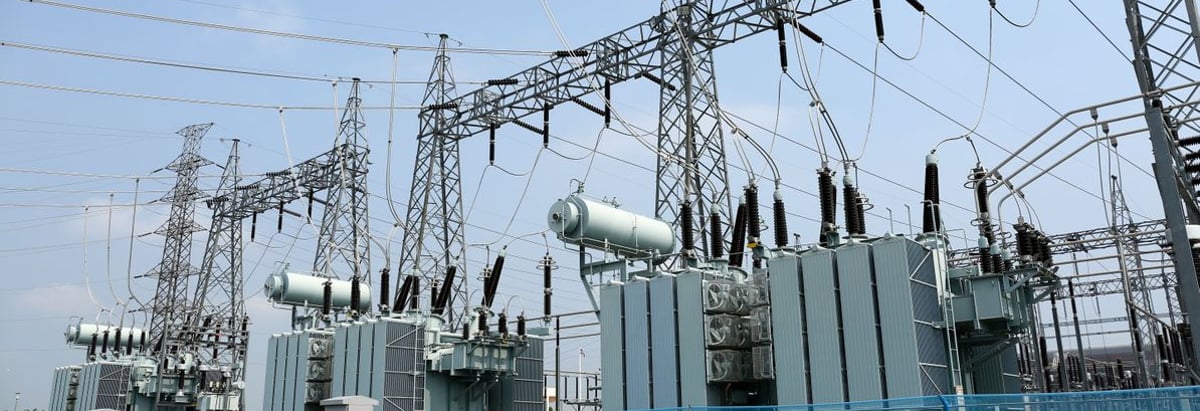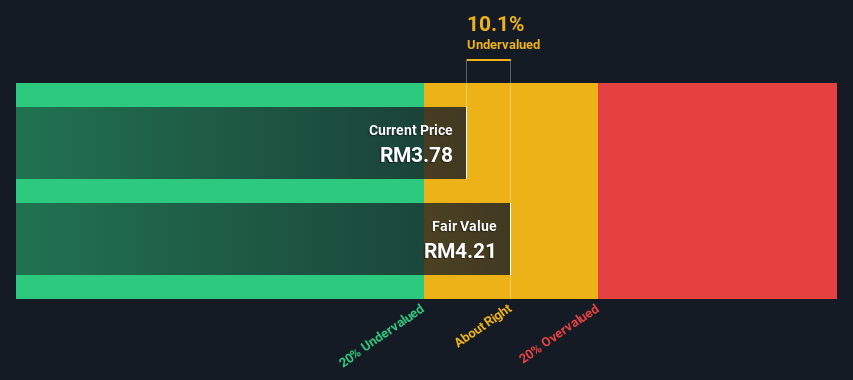- Malaysia
- /
- Other Utilities
- /
- KLSE:YTLPOWR
Estimating The Intrinsic Value Of YTL Power International Berhad (KLSE:YTLPOWR)

Key Insights
- YTL Power International Berhad's estimated fair value is RM4.21 based on 2 Stage Free Cash Flow to Equity
- With RM3.78 share price, YTL Power International Berhad appears to be trading close to its estimated fair value
- Our fair value estimate is 8.8% higher than YTL Power International Berhad's analyst price target of RM3.87
Does the February share price for YTL Power International Berhad (KLSE:YTLPOWR) reflect what it's really worth? Today, we will estimate the stock's intrinsic value by taking the forecast future cash flows of the company and discounting them back to today's value. We will take advantage of the Discounted Cash Flow (DCF) model for this purpose. Models like these may appear beyond the comprehension of a lay person, but they're fairly easy to follow.
Remember though, that there are many ways to estimate a company's value, and a DCF is just one method. Anyone interested in learning a bit more about intrinsic value should have a read of the Simply Wall St analysis model.
See our latest analysis for YTL Power International Berhad
The Model
We use what is known as a 2-stage model, which simply means we have two different periods of growth rates for the company's cash flows. Generally the first stage is higher growth, and the second stage is a lower growth phase. To begin with, we have to get estimates of the next ten years of cash flows. Where possible we use analyst estimates, but when these aren't available we extrapolate the previous free cash flow (FCF) from the last estimate or reported value. We assume companies with shrinking free cash flow will slow their rate of shrinkage, and that companies with growing free cash flow will see their growth rate slow, over this period. We do this to reflect that growth tends to slow more in the early years than it does in later years.
Generally we assume that a dollar today is more valuable than a dollar in the future, so we discount the value of these future cash flows to their estimated value in today's dollars:
10-year free cash flow (FCF) estimate
| 2024 | 2025 | 2026 | 2027 | 2028 | 2029 | 2030 | 2031 | 2032 | 2033 | |
| Levered FCF (MYR, Millions) | RM2.90b | RM2.84b | RM3.63b | RM2.04b | RM1.97b | RM1.94b | RM1.94b | RM1.97b | RM2.00b | RM2.05b |
| Growth Rate Estimate Source | Analyst x3 | Analyst x2 | Analyst x3 | Analyst x1 | Est @ -3.39% | Est @ -1.31% | Est @ 0.15% | Est @ 1.16% | Est @ 1.88% | Est @ 2.38% |
| Present Value (MYR, Millions) Discounted @ 8.6% | RM2.7k | RM2.4k | RM2.8k | RM1.5k | RM1.3k | RM1.2k | RM1.1k | RM1.0k | RM952 | RM897 |
("Est" = FCF growth rate estimated by Simply Wall St)
Present Value of 10-year Cash Flow (PVCF) = RM16b
After calculating the present value of future cash flows in the initial 10-year period, we need to calculate the Terminal Value, which accounts for all future cash flows beyond the first stage. For a number of reasons a very conservative growth rate is used that cannot exceed that of a country's GDP growth. In this case we have used the 5-year average of the 10-year government bond yield (3.5%) to estimate future growth. In the same way as with the 10-year 'growth' period, we discount future cash flows to today's value, using a cost of equity of 8.6%.
Terminal Value (TV)= FCF2033 × (1 + g) ÷ (r – g) = RM2.1b× (1 + 3.5%) ÷ (8.6%– 3.5%) = RM42b
Present Value of Terminal Value (PVTV)= TV / (1 + r)10= RM42b÷ ( 1 + 8.6%)10= RM18b
The total value, or equity value, is then the sum of the present value of the future cash flows, which in this case is RM34b. To get the intrinsic value per share, we divide this by the total number of shares outstanding. Relative to the current share price of RM3.8, the company appears about fair value at a 10% discount to where the stock price trades currently. Remember though, that this is just an approximate valuation, and like any complex formula - garbage in, garbage out.

Important Assumptions
We would point out that the most important inputs to a discounted cash flow are the discount rate and of course the actual cash flows. If you don't agree with these result, have a go at the calculation yourself and play with the assumptions. The DCF also does not consider the possible cyclicality of an industry, or a company's future capital requirements, so it does not give a full picture of a company's potential performance. Given that we are looking at YTL Power International Berhad as potential shareholders, the cost of equity is used as the discount rate, rather than the cost of capital (or weighted average cost of capital, WACC) which accounts for debt. In this calculation we've used 8.6%, which is based on a levered beta of 0.800. Beta is a measure of a stock's volatility, compared to the market as a whole. We get our beta from the industry average beta of globally comparable companies, with an imposed limit between 0.8 and 2.0, which is a reasonable range for a stable business.
SWOT Analysis for YTL Power International Berhad
- Earnings growth over the past year exceeded the industry.
- Dividends are covered by earnings and cash flows.
- Interest payments on debt are not well covered.
- Dividend is low compared to the top 25% of dividend payers in the Integrated Utilities market.
- Good value based on P/E ratio and estimated fair value.
- Debt is not well covered by operating cash flow.
- Annual earnings are forecast to decline for the next 3 years.
Looking Ahead:
Valuation is only one side of the coin in terms of building your investment thesis, and it shouldn't be the only metric you look at when researching a company. It's not possible to obtain a foolproof valuation with a DCF model. Instead the best use for a DCF model is to test certain assumptions and theories to see if they would lead to the company being undervalued or overvalued. For instance, if the terminal value growth rate is adjusted slightly, it can dramatically alter the overall result. For YTL Power International Berhad, we've put together three essential factors you should consider:
- Risks: For instance, we've identified 3 warning signs for YTL Power International Berhad (2 are significant) you should be aware of.
- Future Earnings: How does YTLPOWR's growth rate compare to its peers and the wider market? Dig deeper into the analyst consensus number for the upcoming years by interacting with our free analyst growth expectation chart.
- Other High Quality Alternatives: Do you like a good all-rounder? Explore our interactive list of high quality stocks to get an idea of what else is out there you may be missing!
PS. Simply Wall St updates its DCF calculation for every Malaysian stock every day, so if you want to find the intrinsic value of any other stock just search here.
New: Manage All Your Stock Portfolios in One Place
We've created the ultimate portfolio companion for stock investors, and it's free.
• Connect an unlimited number of Portfolios and see your total in one currency
• Be alerted to new Warning Signs or Risks via email or mobile
• Track the Fair Value of your stocks
Have feedback on this article? Concerned about the content? Get in touch with us directly. Alternatively, email editorial-team (at) simplywallst.com.
This article by Simply Wall St is general in nature. We provide commentary based on historical data and analyst forecasts only using an unbiased methodology and our articles are not intended to be financial advice. It does not constitute a recommendation to buy or sell any stock, and does not take account of your objectives, or your financial situation. We aim to bring you long-term focused analysis driven by fundamental data. Note that our analysis may not factor in the latest price-sensitive company announcements or qualitative material. Simply Wall St has no position in any stocks mentioned.
About KLSE:YTLPOWR
YTL Power International Berhad
An investment holding company, provides electricity, clean water, sewerage system, and telecommunication services in Malaysia, Singapore, the United Kingdom, and internationally.
Fair value with limited growth.
Market Insights
Community Narratives




